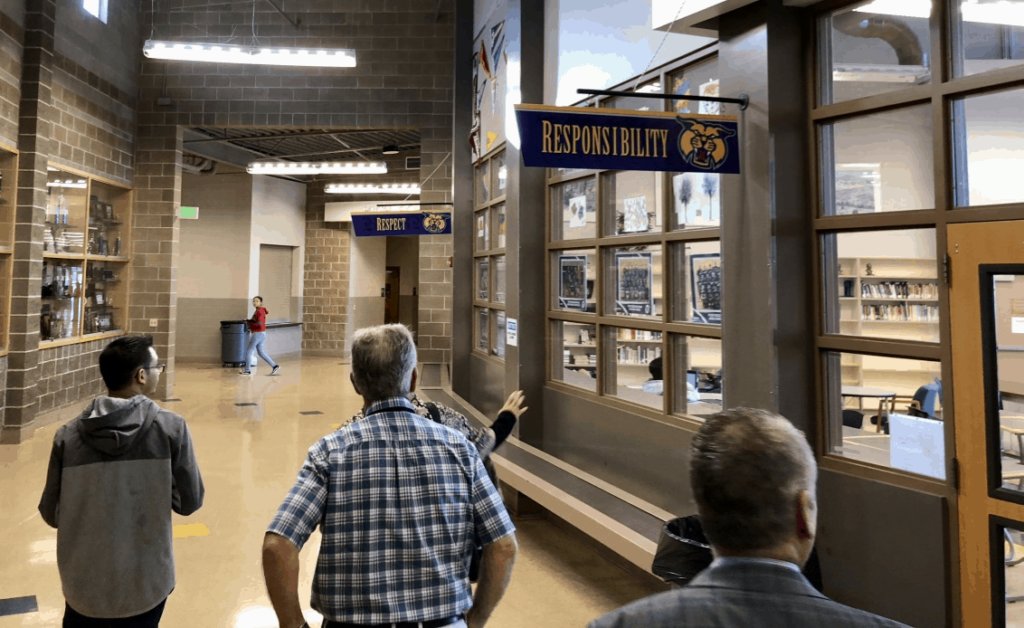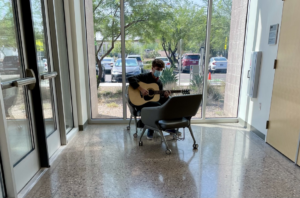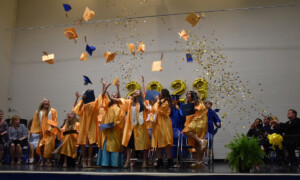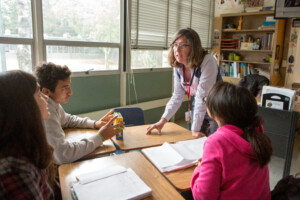Moving to Mastery in Idaho

Raul (above left) is a high school senior succeeding in three college courses. Despite growing up in a small low-income farming community, he’s confident in his academic skills because he attends a school where learners progress after demonstrating mastery. (Raul is providing a tour to state legislators above.)
The two schools in the town of Wilder serve 500 elementary and secondary students. Located in the Snake River Valley, 30 miles west of Boise, many parents of Wilder students work in a Simplot plant that supplies French fries to McDonald’s, or a big meat processing plant north of town, or support farms of corn and hops.
Nearly all Wilder students live in or near poverty. Many move frequently and are new to English. Despite the challenges, Wilder schools are innovating in a dozen ways that makes them worth visiting.
1. Students have voice and choice in learning; they can choose the best way for them to learn: in class, online, or through projects.
2. Every student develops a personal learning plan with their mentor.

3. Instead of bells and chaotic passing periods, Wilder student go where they need to go when they need to go (which adds a couple of weeks of learning time each year).
4. The schools are mastery-based. Students get the time and attention they need to master important knowledge and skills at a high level.
5. A mental health professional helps students deal with the impacts of trauma.
6. Every K-12 student has an iPad (with mobile connectivity) in part thanks to an Apple ConnectEd grant.
7. Teachers target 1.5 years growth each year for students— 2 years of growth for learners that enroll well behind their age cohort.
8. Teachers get a half day each Wednesday to work together.
9. High school students can take college credit courses at school or online. Almost all Wilder seniors graduate with college credit.
10. Wilder teachers focus on habits of mind and create positive discipline options that change behaviors.
11. In a well-equipped studio, middle school students create animated films.
12. To welcome and inform all the visitors to Wilder schools, every classroom has a skilled and informed student ambassador.

Jeff Dillon (above) grew up in Wilder. Ten years ago, he returned to his hometown to serve as elementary principal. Six years ago, the board added Superintendent to his title.
Wilder schools joined the Idaho Mastery Education Network two years ago. The goal of the program is to “move students away from the current time-based system to a mastery-based system to allow for a more personalized and differentiated learning experience” with a “focus on explicit, measurable, transferable learning objectives that will empower students and prepare them for the 21st Century.”
Nineteen Idaho districts and incubators have received more than $1 million in funding to support 32 schools. Grants provide professional development, travel, technology, teacher stipends and supplies.
“All of the districts/schools were given a seat time waiver,” said Kelly Brady, Director of Mastery Education for the Idaho State Department of Education. “There is a great amount of work devoted to policy and procedures that are either perceived or real barriers as we make the needed changes for success and equality for all Idaho students.”
“Technical assistance and professional development continue to be an important aspect of making the need shifts during the planning/design phase and the implementation phase,” added Brady.
Dillon said, “We’re finding success in building student ownership for learning.”
There was some staff turnover with the new program said Dillon. “Mastery makes clear which teachers are the most effective.”
The mastery approach, said Dillon, requires “great teachers that can connect with students,” and “leaders passionate about the progress of individual students.”
Synergy in Kuna
Synergy is student-centered academy at Kuna Middle School in a southwestern suburb of Boise. A team of four teachers supports just over 100 students using the Summit Learning platform.
Teachers supplement the personalized learning system with big integrated projects. Students conduct exhibitions of learning three times a year.
Students set academic goals with their mentors every week. Each student has a unique Google calendar schedule tied to their academic goals.
The large classrooms have a variety of seating arrangements including desk, tables, and couches for individual and team activities.

Wendy Johnson is superintendent of the Kuna School District. She has allowed the academy to remain a small open enrollment experiment. Based on early success, a second team at Kuna Middle School and a third team at Fremont Middle School implemented the Summit Learning platform.
Idaho school visits to Wilder and Kuna by state legislators were sponsored by the NCSL Student-Centered Learning Commission. The commission is exploring personalized and competency-based learning that enables students ownership over their learning and takes place anytime, anywhere.
For more, see:
- The Promise & Challenge of Student-Centered Learning (notes from the NCSL session)
- How Idaho Is Moving Towards Mastery-Based Education (by Kelly Brady)
- On Becoming Student-Centered and Mastery-Based (podcast with Susan Bell)
Stay in-the-know with all things EdTech and innovations in learning by signing up to receive the weekly Smart Update.








0 Comments
Leave a Comment
Your email address will not be published. All fields are required.